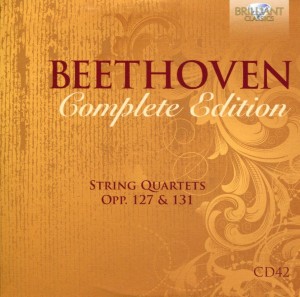 I’m not a musicologist. I have no idea just by listening to a piece of music what key it’s in.
I’m not a musicologist. I have no idea just by listening to a piece of music what key it’s in.
I couldn’t even tell you its time signature.
Oh, I could get out my guitar and finger the frets to find the key something is in. But I doubt I could count out a time signature.
So I’m always amazed to discover Beethoven’s music is much more complicated than one might think.
For example, from its entry on Wikipedia, there’s this about String Quartet No. 12 in E Flat Op. 27:
The first movement is twice interrupted – just before the development of the sonata form begins, and when that section is almost but not quite over – by recurrences of the opening’s Maestoso music.
The immense second movement is in the subdominant key of A♭ major. It consists of a set of six variations and a coda. The first variation is in 12/8 meter with darker harmonies and quick changes in dynamics. The second variation increases the tempo to andante con moto and adjusts the meter to 4/4. Here, the two violins engage in a dialogue over staccato accompaniment. he third variation shifts to E major, enharmonically the flat submediant, and the tempo shifts to a hymn-like adagio molto espressivo. The fourth variation returns to 12/8 and drops a half-step to the dominant key of E♭ major. This variation has a codetta which transitions the key to D♭ major in preparation for the next variation. The fifth variation is sotto voce and has been called a “mysterious episode” and begins in D♭ major and transitions to the parallel C♯ minor. The recapitulatory sixth variation returns to 12/8, presents only half of the theme and connects directly to the coda.
Uh, yeah.
The Wiki article goes on and on and on about the intricacies of this piece of music, which I find fascinating on one, probably really deep, level. Probably the same level that enjoys knowing who the producers, musicians, and recording-studio antics were for important albums from my teen years, albums like Live Album by Grand Funk Railroad, Brain Salad Surgery by ELP, Made in Japan by Deep Purple, Sheer Heart Attack by Queen, Desolation Boulevard by Sweet, They Only Come Out at Night by Edgar Winter, and Montrose by Montrose.
Yet, on another level, I sometimes worry that I’m missing the forest for the trees. Or, in this case, I’m missing the sonata for the enharmonically flat submediants.
At some point, music is just music. It moves or it does not. And no amount of knowing its time signatures is going to matter in the long run. It may enhance one’s appreciation on an intellectual level. But it won’t necessarily move one’s feet or touch one’s soul.
Classical music is bit of an exception to that rule because it often does both – stirs the soul and strokes the synapses of the brain. Emotion and intellect combined.
That’s not to say one had to check his intellect at the door while listening to, say, Live Album by Grand Funk. But it probably wouldn’t hurt.
For me, knowing the circumstances surrounding the creation of a particular piece of music often enhances my appreciation of it.
For example, this composition from Beethoven. It was completed in 1825. Beethoven was 55 and nearly stone deaf.
In other parts of the world, Jane Austen had written all of her most famous novels – Sense and Sensibility (1811), Pride and Prejudice (1813), Mansfield Park (1814), Emma (1816), and Persuasion and Northanger Abbey (1818). Mary Shelley had written Frankenstein (1818).
A decade earlier, America had emerged from the War of 1812.
In 1825, John Quincy Adams was chosen President in a hotly contested race that was decided by the House of Representatives.
Beethoven had a library, and he apparently read a lot. And not just music theory, either. Visit this page to see what Beethoven read.
Here’s the point: whenever I listen to these Classical musicians, I like to form a mental picture in my mind of what life was like for them, how old they were, what the world was like, what else was going on around the same time.
I don’t know why I like doing that. I just like to see/hear things in context. It helps me understand the composer a little better.
The other composition on Beethoven CD 42 is String Quartet No. 14 in C Sharp Minor Op. 131.
All compositions on today’s CD are performed by the Suske Quartett:
Karl Suske violin I
Klaus Peters violin II
Karl-Heinz Dommus viola
Matthias Pfaender cello
incidentally, today’s number – 237 – is also the number of the room in the creepy horror movie The Shining.
That hasn’t nothing to do with Beethoven.
